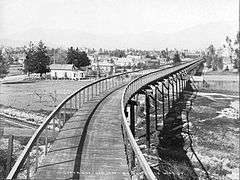California Cycleway

The California Cycleway, opened in 1900, was an elevated tollway built specially for bicycle traffic through the Arroyo Seco, intended to connect the cities of Pasadena and Los Angeles, in California, United States.
Construction
The inventor and promotor of the cycleway was Pasadena resident Horace Dobbins, who attracted ex-California governor Henry Harrison Markham to join him in the venture. Together, the two sought approval from the California state legislature, which was ultimately granted (after a first attempt was vetoed) in 1897. The California Cycleway Company bought a six-mile (10 km) right-of-way from downtown Pasadena to Avenue 54 in Highland Park, Los Angeles.[1]
Construction began in 1899, and about 1.3 miles (2 km) of the elevated wooden bikeway were opened on January 1, 1900, starting near Pasadena's Hotel Green and ending near the Raymond Hotel. The majority of its route is now Edmondson Alley. A toll booth was located near the north end, in the present Central Park. Had the full route been completed, it would have continued past Highland Park, on through Montecito Heights, crossed the Los Angeles River, passed Elysian Park, and continued to the Plaza in Los Angeles. The full nine-mile run would have had a maximum grade of 3% and an average grade slightly over 1%. At its highest point, the elevation of the roadway was 50 feet (15 m).
The portion built was constructed almost entirely of Oregon pine and was wide enough for four cyclists to ride abreast, with provision for eventual doubling of the width. It was painted dark green and, at night, brightly lit with incandescent lights. The toll was 10 cents one-way, or 15 cents round trip.[2][3]
- The California Cycleway
 Looking south from Hotel Green, 1900
Looking south from Hotel Green, 1900 Looking north towards Hotel Green, 1904
Looking north towards Hotel Green, 1904 At the Grand Opera House
At the Grand Opera House
Dismantling
Due to the end of the bicycle craze of the 1890s and the existing Pacific Electric Railway lines connecting Pasadena to Los Angeles, the cycleway never made a profit, and never extended beyond the Raymond Hotel into the Arroyo Seco. In the first decade of the 20th century, the structure was dismantled, and the wood sold for lumber,[4][5] and the Pasadena Rapid Transit Company, a failed venture headed by Dobbins to construct a streetcar line, acquired the right-of-way.[6][7] Later, the California Cycleway's right-of-way became part of the Arroyo Seco Parkway (Pasadena Freeway).
See also
- Arroyo Seco Parkway
- West Los Angeles Veloway
- San Rafael Hills
- List of Los Angeles Historic-Cultural Monuments on the East and Northeast Sides
-
_pictogram.svg.png) Cycling portal
Cycling portal
References
- ↑ Dan Koeppel, "Cycleway", in: LAttitudes. An Angeleno's Atlas. Ed. Patricia Wakida. Berkeley: Heyday, 2015, pp. 96-105
- ↑ "Horace Dobbin's Cycleway". California Cycleways. Retrieved 27 July 2010.
- ↑ Denham, T.D. "California's Great Cycle-Way". Good Roads Magazine (November, 1901). Retrieved 27 July 2010.
- ↑ Ann Scheid, Downtown Pasadena's Early Architecture, Arcadia Publishing, 2006, pp. 78-79
- ↑ Rick Thomas, South Pasadena, Arcadia Publishing, 2007, pp. 60-65
- ↑ Los Angeles Times, Dash into Pasadena in Twelve Minutes, January 1, 1909, p. II1
- ↑ Historic American Engineering Record, "Arroyo Seco Parkway" (HAER No. CA-265)
External links
| Wikimedia Commons has media related to California Cycleway. |
- Roads Were Not Built For Cars Blog: "California Cycleway was scuppered by cars (street-cars, that is, not motor-cars)" — in depth history.
- Highland Park Blog: "Remembering The Great California Cycleway" — with images.
- SierraClub.org: "Bikeway or the Highway" — by Robert Gottlieb.